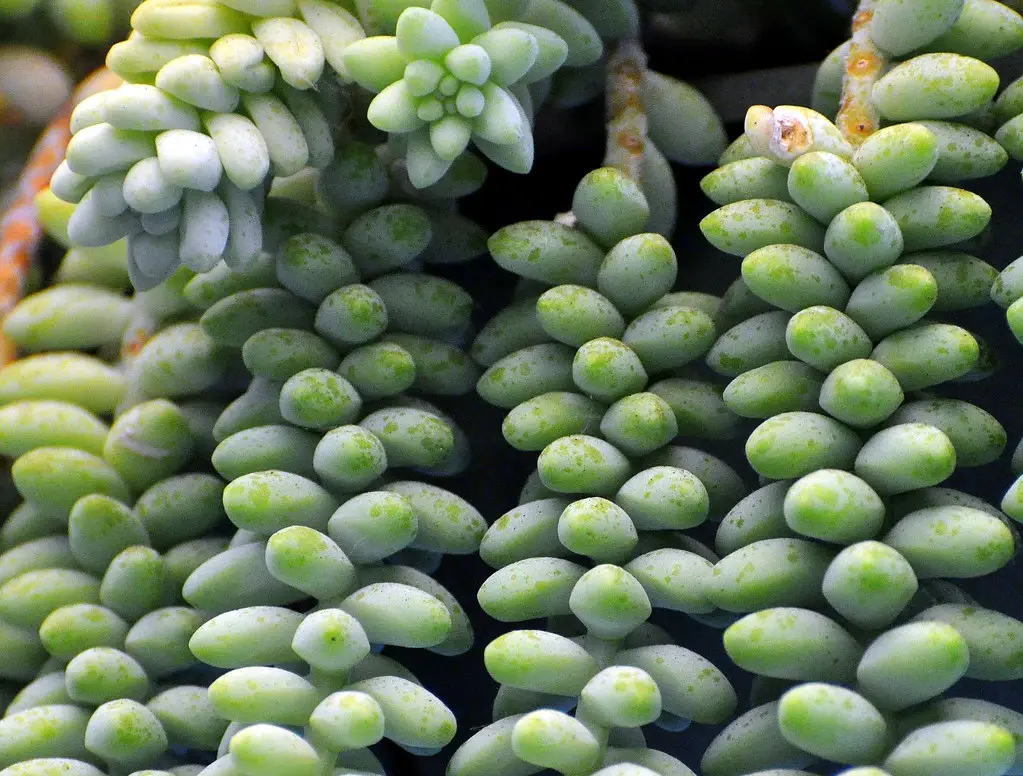Burro’s Tail, a captivating succulent, is beloved for its unique trailing growth and thick, plump leaves. Its cascading stems, laden with teardrop-shaped leaves, resemble a donkey’s tail, giving rise to its common name. As a member of the genus Sedum, this plant is both visually appealing and relatively easy to care for, making it a popular choice for both novice and seasoned gardeners.
Native to Honduras and Mexico, Burro’s Tail thrives in arid environments and is well-suited to indoor cultivation. Often found adorning hanging baskets or as a standout feature in a mixed succulent garden, its fleshy, blue-green leaves and trailing growth habit provide a striking visual contrast to other plants.
In addition to its ornamental beauty, Burro’s Tail is also known for its drought tolerance. As a succulent, it has developed adaptations to store water in its leaves, allowing it to endure periods of dryness. Its resilience and distinctive appearance have helped cement its status as a favored houseplant around the world.
| Attribute | Details |
|---|---|
| Common Names | Burro’s Tail, Donkey’s Tail |
| Botanical Name | Sedum morganianum |
| Family | Crassulaceae |
| Plant Type | Succulent |
| Mature Size | 2-3 feet long |
| Sun Exposure | Partial shade |
| Soil Type | Well-draining cactus mix |
| Hardiness Zones | 10-11 |
| Native Area | Honduras, Mexico |
Burro’s Tail Care
Caring for Burro’s Tail is relatively straightforward, primarily revolving around proper light, soil, and watering practices. Like many succulents, it prefers a dry, well-ventilated environment, making it an ideal choice for indoor growing.
Positioning the plant in the right spot, using suitable soil, and following a consistent watering schedule will promote healthy growth. Additionally, its shallow root system requires careful attention to watering and soil conditions to prevent rot or other complications.
Light Requirement for Burro’s Tail
Burro’s Tail thrives in bright but indirect sunlight. Too much direct sunlight can lead to sunburn, while insufficient light can cause leggy growth. A spot near a north or east-facing window or using a shade cloth to diffuse bright sunlight is ideal.
Soil Requirements for Burro’s Tail
A well-draining cactus or succulent mix is best for Burro’s Tail. Avoid heavy, water-retentive soils that can lead to root rot. Adding sand or perlite to a standard potting mix can also create the desired drainage conditions.
Water Requirements for Burro’s Tail
Watering should be done sparingly, allowing the soil to dry out between watering. Overwatering can lead to rot, while underwatering may cause leaves to drop.
Temperature and Humidity
Burro’s Tail prefers a warm, dry climate and can suffer in cold or humid conditions. It’s best kept at temperatures above 60°F (15°C) and away from drafts or sudden temperature changes.
Fertilizer
A balanced, water-soluble fertilizer diluted to half strength can be applied once in the growing season (spring or summer). Avoid over-fertilizing, as this can lead to weak, leggy growth.
Pruning Burro’s Tail
Pruning is rarely necessary but can be done to shape the plant or remove dead or damaged stems. Snip off the unwanted growth at the stem.
Propagating Burro’s Tail
Propagating Burro’s Tail is simple and can be done through leaf or stem cuttings. Allow the cuttings to callus for a day or two before planting in well-draining soil.
How To Grow Burro’s Tail From Seed
Growing from seed is possible but more challenging. Sow seeds in a well-draining mix, keep moist but not soggy, and provide bright, indirect light.
Common Pests & Plant Diseases
Mealybugs
Easily controlled by wiping with a cloth dipped in alcohol.
Root Rot
Usually caused by overwatering and can be avoided with proper watering practices.
Common Problems With Burro’s Tail
Leaf Drop
Caused by various stress factors such as overwatering, temperature changes, or handling. Maintain consistent care practices.
Legginess
Occurs when the plant receives insufficient light. Move to a brighter location.
Pro Tips
- Avoid frequently handling the plant as the leaves can easily detach.
- Use a container with drainage holes to prevent waterlogging.
- Provide proper airflow to reduce humidity and deter pests.
- Repot only as necessary, as Burro’s Tail prefers to be somewhat root-bound.




